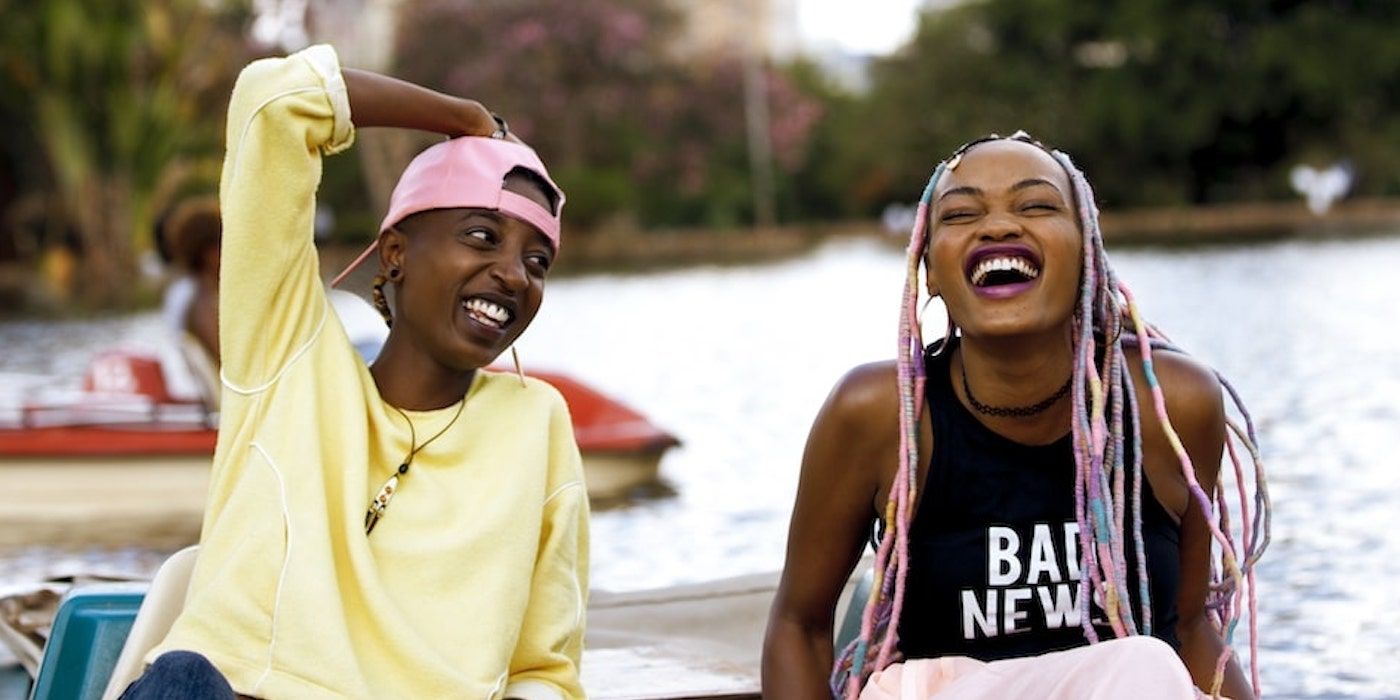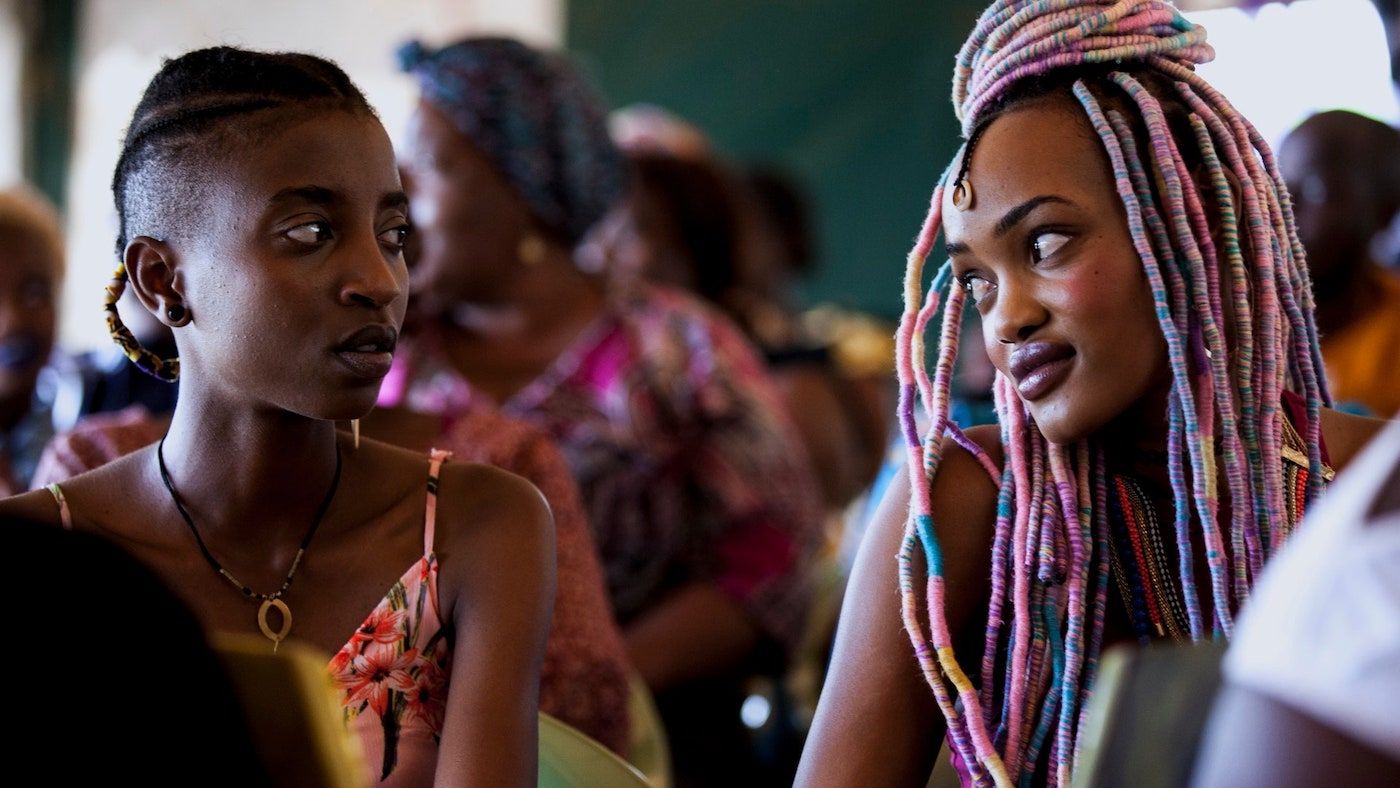One of the more frequent complaints among avid viewers of LGBTQIA+ cinema centers on an over-emphasis on queer pain rather than queer joy. From the devastating conclusions of films as varied as William Wyler’s foundational lesbian drama The Children’s Hour and Gregg Araki’s boundary pushing The Living End to the emphasis on repression or personal pain in films like Sunday Bloody Sunday and Brokeback Mountain, many of the essential films in the queer cinema canon center their narratives on the hardships of queer life and love.
Although tales of struggle are necessary for acknowledging the sociopolitical crucible in which queer liberation was and is still being forged, one of the many benefits of expanding queer visibility in contemporary cinema is an emphasis on the joy of personal expression and romantic connection in queer life. Through her use of kaleidoscopic colors and examination of vibrant alternate spaces for social connection, Kenyan filmmaker Wanuri Kahiu’s coming-of-age romance Rafiki provides a refreshingly light perspective into the highs and lows of queer love. Centered on the romantic interest between Kena (Samantha Mugatsia) and Ziki (Sheila Munyiva) that buds in the midst of their fathers’ opposing bids for a County Assembly in Nairobi, Rafiki elegantly interweaves the sociopolitical complexities and postcolonial traumas of Kenya’s general approach to homosexuality without slipping into dour didacticism. Instead, Rafiki boldly demonstrates the possibility of queer joy and happy endings in the midst of the ambiguities of cultural progression.
In order to assess Kahiu’s beautiful ruminations on Kena and Ziki’s romance, it is essential to acknowledge the sociopolitical difficulties that Kahiu and her cast expertly navigate in their assessment of postcolonial Africa’s systemic homophobia. The entire narrative of Rafiki takes place in previously colonized African spaces which are still reckoning with the individual and collective traumas of colonialism. In Rafiki, homophobia manifests in a variety of postcolonial spaces of interpersonal connection including the local church, cafes in the town center, and even the politicians’ homes, all of which contribute to the violent attack against Kena and Ziki in the film’s climactic moments. Yet even as Rafiki doubles down on the deep-seated homophobic systems that permeate the daily lives of the central characters, Kahiu elevates an equal number of alternative spaces in which Kena and Ziki can safely commune, especially the local dance club and the abandoned van that transforms into a safe haven for the central duo.
Upon first connecting with Ziki on the level of friendship, Kena finds herself drawn to Ziki’s multicolored hair, which functions as a representation of self-confidence, personal expression, and unabashed individuality in the eyes of the more reserved Ziki. Quickly, the mutual attraction between Ziki and Kena blossoms into an intimate and youthful yet mature romance, littered with secretive local dates and subtle romantic gestures in the midst of gatherings with friends. Ebbing and flowing between quiet spaces around Nairobi and found locations for secret meetings, Ziki and Kena beautifully encapsulate the vulnerability of queer love, as public homosexuality remains illegal in Kenya. One of the films boldest instances of romantic connection comes in the colorful club-set sequence, which sees Kena and Ziki dance and embrace surrounded by gleeful strobing lights and upbeat music. By affording the central couple a space for joyful mutual expression of infatuation and attraction, Rafiki illuminates the possibility for hope within perpetual structures of queer repression, emboldening her international audience toward more comfortable romantic expression.
In addition to visualizing the club as a symbolic safe space for queer freedom, Rafiki includes several extended sequences of Kena and Ziki spending time in a flower-covered abandoned van. Extending from an early date sequence of the couple paddle-boating in a local waterway, Kahiu uses the space of the van as a symbolic expression of forward mobility, allowing Kena and Ziki’s dreams of running away together to encapsulate a slow-but-steady movement across Kenya towards queer liberation. By allowing the audience into the private conversations and moments of connection between Kena and Ziki in the van, Kahiu advances her distinct vision of queer love as a bond founded upon dreams of political change and potential mobility beyond the restrictions of heteronormative society. Even as the film depicts Kena’s mother and Ziki’s parents as representatives of the heteropatriarchal structures that colonialism contributed to the sociopolitical landscape of Kenya, Rafiki refuses to give the systemic oppression the final word in the central couple’s story. Kahiu’s use of soft pastel colors in intimate moments and vibrant neon shades in scenes of public queer expression allow the protagonists’ identities to fill the frames with light and life, even as they confront the ambiguities of their future together.
While Rafiki bravely confronts the pain and prejudice that Kena and Ziki experience at the hands of their community in Kenya, the film also provides audiences with a refreshing rarity in queer cinema—a happy ending. In the final moments of the film that take place at an undefined point in the future, Kena returns to her home outside of Nairobi, where she is greeted by Ziki. Although the camera only visualizes Ziki’s hand caressing Kena’s shoulder, the intimacy of the moment and joy on Kena’s face set up an ambiguously triumphant ending. This sequence is a perfect example of Kahiu’s visual aesthetic and ideological approach throughout the film, allowing the empathetic intimacy of the central bond to pour into the final frames. Even as the audience never encounters the gap in time between the present day ending and the future-set epilogue, the beautiful reunion between Kena and Ziki becomes a multilayered encapsulation of the ambiguous hope that defines many queer relationships. While many films have understandably leaned into the hardships faced by the LGBTQIA+ community in the face of discrimination for their personal and sexual liberties, Rafiki chooses to be a vibrant neorealist fable for the joyful possibilities of altering systems through authentic love. By decentering the inherent homophobia of colonialism to praise the potential for contemporary sociopolitical movements in Kenya within the narrative, Rafiki gestures towards the possibility for queer liberation through political change.


